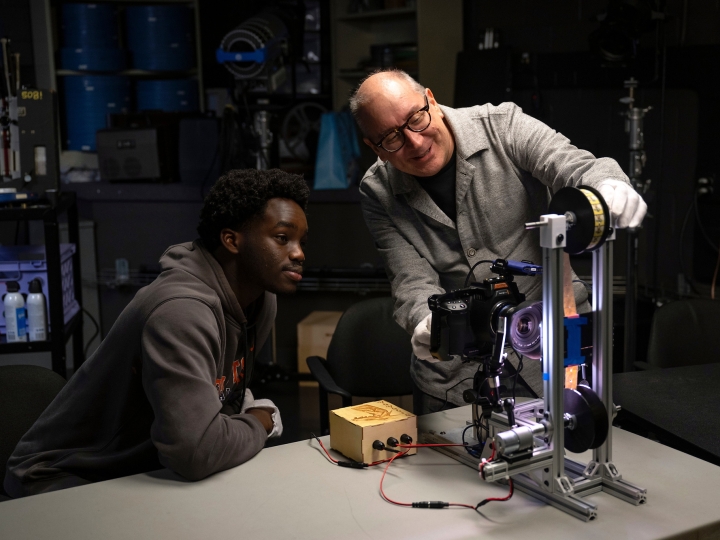The Buzz at Bucknell: ‘Bee Dome’ Arises on Campus
August 28, 2018
The Bucknell University campus is a great place to be a bee. From the magenta Kanzan cherry blossoms shading Malesardi Quadrangle to the pollinator garden outside the Rooke Science Center and the ample flower beds and shrubs that beautify every building, it's a veritable buffet for pollinators.
But for bee researcher and professor Beth Capaldi, these visual delights also present a problem: Surrounded by such bounty, how can she get a bee to focus on the specific flowers she's interested in?
Find Your Path
Controlling the environment is crucial to the research done by Capaldi and her students, which examines how bees perceive and make behavioral choices about the world around them. Her solution to this challenge is a new laboratory on campus that Capaldi, biology and animal behavior, has dubbed the "bee dome," a hoop-house structure 60 feet long by 12 feet wide and 12 feet tall, covered with an insect mesh that allows air and sunlight to filter in. Erected this summer next to the David Burpee Greenhouse on West Campus, the structure allows Capaldi to control experiment variables while maintaining an environment that simulates nature as closely as possible.
"Strangely, bees do really well in these mesh settings, while they don't do well in glass greenhouses for the kind of behavior I want to watch," she said. "Their behavior improves when they're in a somewhat natural environment and it's really too hot and shiny in a greenhouse."
A Multitude of Uses
Capaldi purchased the dome with a Dean's Fellowship from the College of Arts & Sciences, which offers financial support for ongoing research beyond what regular departmental funds can provide. Because it's a significant investment, she is keen to make maximum use of the facility, not only to benefit her own research, but also that of her students and colleagues.
In fact, her first experiment in the dome is a collaboration with fellow biology professor Chris Martine, a botanist who has grown on campus several species of wild eggplants, including some that he discovered in the Australian Outback. Capaldi will be using the plants in a study examining how Eastern bumblebees make choices about the flowers they pollinate.
"We want to know more about the instinctive behavior of bumblebees and determine if they get better at navigating the male and female flowers as they learn," Capaldi explained. "We can do that because we can keep track of individual bees in an enclosed environment like this."
She's also partnering with the newly launched Campus Farm initiative, working with biology professor Mark Spiro and Farm & Garden Coordinator Jennifer Schneidman Partica to provide even more benefits to the Bucknell community. Half the space in the dome is currently devoted to growing tomato seedlings that were started inside the greenhouse this spring and during her experiments' off-season (bees can only fly when outside temperatures rise above 45 degrees), the entire dome can be used to extend the garden's growing season, with an attachable clear plastic cover providing extra warmth. Volunteer staff members from Bucknell Facilities also aided in erecting the dome.
Supporting Undergraduate Research
Capaldi's students are also gaining from the facility. She advised six undergraduate researchers and one graduate student on various bee-related projects this summer.
"I challenge my students to come up with behavioral experiments that allow us to infer what the bees understand about the world," she said. "We make artificial flowers to test their memories. We can train bees to fly in a flight chamber or inside the bee dome and to learn to make associations between sugar concentration and floral colors. By watching them carefully, we can determine how they solve spatial problems and understand their floral choice behaviors. Designing a good experiment is the creative part of the scientific process."
Master's student in animal behavior Madeleine Knott M'19 is one of those students. She spent the summer working with Capaldi on a research project that saw her observing bees pollinating wild eggplants in the bee dome and counting grains of pollen the bees collected under a microscope.
"I love studying animal behavior, especially being able to work with the bumblebees one on one," said Knott, who is considering a career in science education. "I'm not just reading about them or watching documentaries about them — I actually get to work with them. I think working with animals allows you to learn more than just what you set out to learn with your experiments and it's something I really value."
The bee dome is just the latest research facility Capaldi's students can access. In addition to her lab and "bee annex" next to the Animal Behavior Laboratory on West Campus, Capaldi currently manages five honeybee colonies: three on campus, one at the Chillisquaque Natural Area and one at the Lewisburg Community Garden in downtown Lewisburg.
Put it all together and it means Bucknell isn't just a great place to be a bee, it's also a great place to be a bee researcher.

